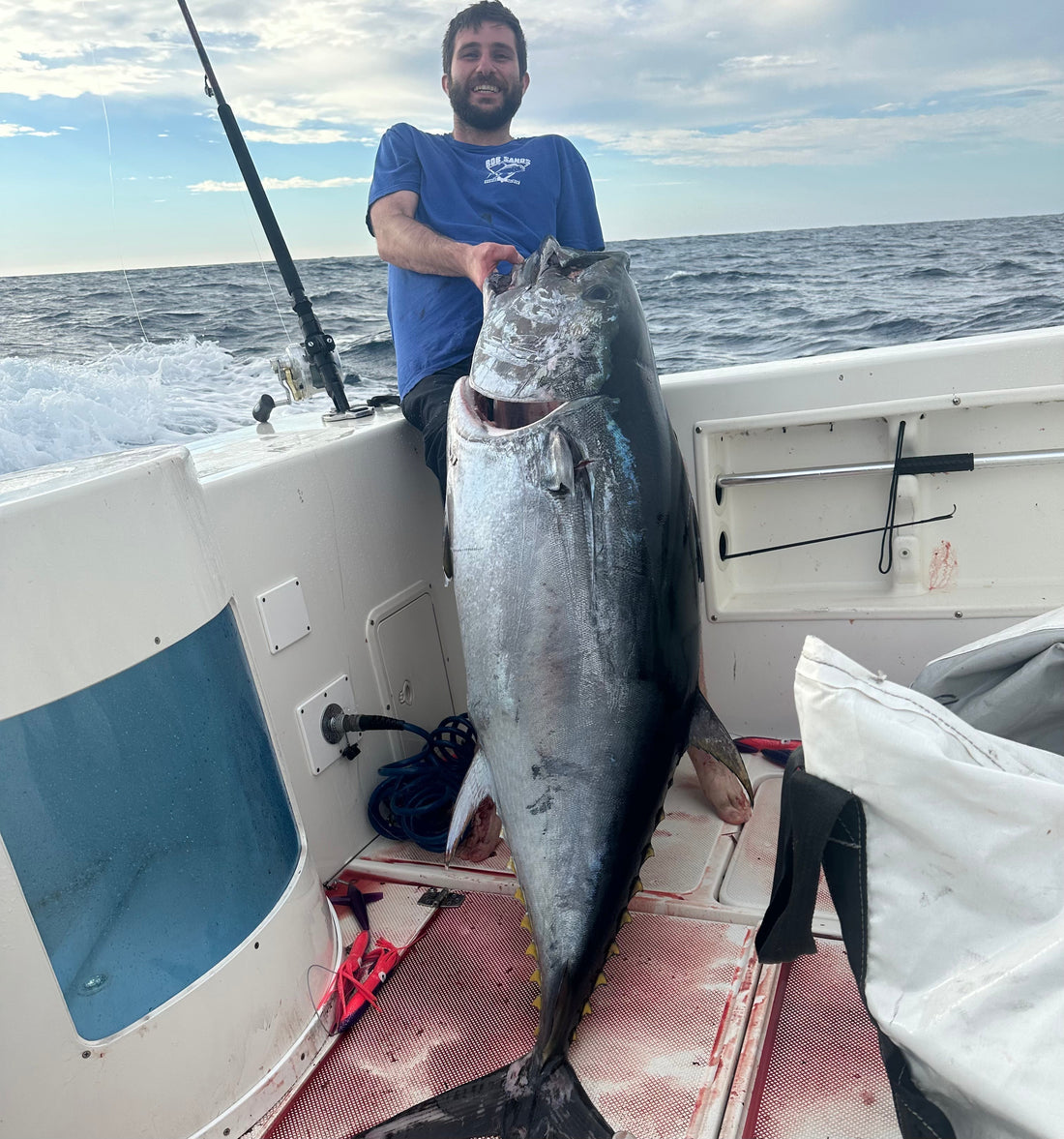
Hunting Tuna with the Bob Sands Boys: Odyssea Spreader Bars and Screaming Reels
Last week, the Bob Sands boys hit the water on a full-on tuna mission. With heavy gear loaded and high hopes, we were ready for anything. By the end of the day, we had four solid tuna on ice, including one absolute beast pushing 140 pounds. Screaming drags, bent rods, and a spreader bar setup that kept the fish coming made it the kind of trip every angler dreams about. Let's discuss the gear we used and break down everything you'll need to prepare for your next trip on the water.
So, What’s a Spreader Bar?
For those new to the game, a tuna spreader bar is a rig designed to mimic a small bait ball of squid. Think of it as a school of snacks skipping across the surface—except all but one are just teasers. The magic happens with the “chase bait” (the hooked squid) trailing just behind the rest. To a tuna, that one looks like the weak straggler, and it usually can’t resist hammering it.
Spreader bars have come a long way since their East Coast beginnings in the 80s. The first ones were clunky and heavy, even rigged with hooks on every teaser (which didn’t last long). Fast forward to today, and companies like Odyssea have perfected the design with lightweight titanium bars that stay durable while keeping the squid dancing on the surface where tuna can’t ignore them.
Let's Talk About Gear!
Nothing gets your heart racing like a reel screaming as a tuna smashes the spread. On this trip, we ran two main setups:
- Talica 50 paired with a UC 76 Invictus – our all-around rig, perfect for the bites that required finesse and control.
- Penn 50 International paired with a GF 775 XXH – the heavy hitter for long runs and the big fish.
We had 100-meter braid with 100lb wind-on leaders, and staggered our lines at 300 feet and 450 feet out to spread the presentation and cover more water.
The highlight? The 140-pounder slammed the pink/purple Odyssea spreader bar on the Talica setup. The reel screamed, the rod bent deep, and it was a full-on battle. Thanks to the line capacity, drag, and sheer backbone of the Talica + UC 76, we were able to finally turn that beast and slide it onto the deck.
That single fight alone made the trip—proof that the right gear, properly set up, and paired with the Odyssea spreader bars makes all the difference.

Colors That Work – And What We Ran
Here’s the deal: every color can work. Odyssea creates an array of options—Tomato, Pink/Purple, Natural, Green/Black, Purple/Black, Brown with Aqua scales, Green Mackerel, Blue Mackerel, and more. On top of that, their interchangeable chase bait system means you can swap colors in seconds.
But tuna are moody. What works in the morning might not get touched in the afternoon. That’s why it pays to mix it up.
On this trip, we ran pink/purple and green, and both got bitten. The pink/purple stood out in the bright sun, flashing hard and pulling fish into the spread. Later in the trip, the green kept getting crushed when the light started to fade. Having both in the water was key—if we had stuck to one, we might’ve missed out.

What Size Bar & Squid Should You Choose?
The idea is simple: match your spreader bar size to the bait that’s naturally in the water. Sometimes tuna are locked in on micro bait and won’t touch anything else. Other times, a 30-pounder will inhale a 13-inch squid like it’s nothing.
That’s why Odyssea makes a range:
- 24-inch “Skiff Special” with 3.5-inch micro squid – small profile, but tough enough for big fish.
- 36-inch bar with 9-inch squid – the “all-arounder” and a killer choice if you’re only bringing one.
- 36–48-inch bar with 11–13-inch squid – upsized when you’re hunting bigger models.
On our trip, we ran the 36-inch medium bar with 9-inch squid, and it flat-out produced. It’s big enough to draw fish in but still natural enough to look like the real deal. The ability to swap chase baits meant we could keep testing colors until we found what worked.

How Fast Do You Run Them?
Speed makes or breaks a spreader bar. Too fast and the bar skips out of the water, too slow and it drags like dead weight.
The recommended range is usually 6–9 knots, but it really depends on the weather and sea conditions. On our trip, with the water being rough, we found that rolling the bars at 4–5 knots gave the best action. The goal is always the same—keep the squid dancing and the bar lively, even when the seas are a little rough.
We Got You Covered!
All the gear we used on this trip is ready for you in our shop. The Odyssea spreader bars are available in-store and online, ready to hit the water—while supplies last, so grab them before they’re gone!
We also have the reels and rods we ran, including the Talica 50 + UC 76 Invictus and Penn 50 International + GF 775 XXH, stocked in-store and online. Need help spooling your line or setting up your gear? Shoot us a message—we’ve got you covered.
Get ready, because your next tuna trip is waiting, and the right setup makes all the difference!
